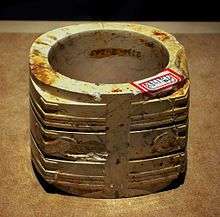Cong (jade)

A cong (Chinese: 琮; pinyin: cóng; Wade–Giles: ts'ung2) is a form of ancient Chinese jade artifact.[1] The earliest cong were produced by the Liangzhu culture (3400-2250 BC); later examples date mainly from the Shang and Zhou dynasties.[2]
|
| |
|
|
In form, a cong is a tube with a circular inner section and squarish outer section. The outer surface is divided vertically or horizontally such that the whole defines a hollow cylinder embedded in a partial rectangular block. Proportions vary - a cong may be squat or taller than it is wide. The outer faces are sometimes decorated with mask-like faces, which may be related to the taotie designs found on later bronze vessels.
Although generally considered to be a ritual object of some sort, the original function and meaning of the cong are unknown. Later writings speak of the cong as symbolizing the earth, while the bi represents the heavens. The square represents the earth and a circle represents the heavens.
Porcelain versions of the cong are also known, as were featured in a BBC TV documentary entitled China in Six Easy Pieces (2013) presented by Lars Tharp, a porcelain specialist.[3]
Further reading
- Les jades néolithiques chinois / [contributions de Christophe Comentale, Laurent Long, Tong Peihua, Zhang Jingguo] ; [pour l'ACI Du chopper au brilliant], [Paris] : Museum national d'histoire naturelle, cop. 2008, 1 vol. (81 p.) : ill., couv. ill. ; 30 cm
- Art et archéologie : la Chine du Néolithique à la fin des Cinq Dynasties, 960 de notre ère / Danielle Elisseeff ; Paris : École du Louvre : RMN, 2008
- "Neolithic Chinese Jades", Angus Forsyth, in Jade. Ed. Roger Keverne. New York: Van Nostrand Reinhold, 1991. pp. 88–109.
References
- ↑ Greg Woolf (2007). Ancient civilizations: the illustrated guide to belief, mythology, and art. Barnes & Noble. p. 216. ISBN 978-1-4351-0121-0.
- ↑ http://arts.cultural-china.com/en/32Arts1376.html
- ↑ http://www.bbc.co.uk/programmes/b036r5cx